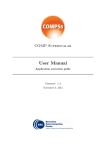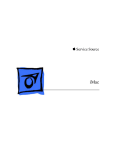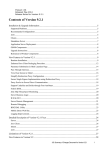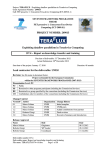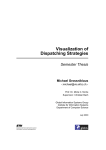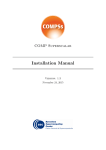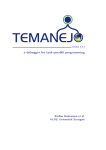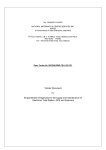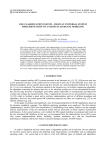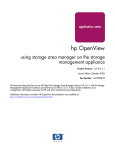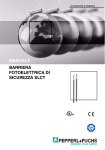Download COMPSs User Manual: Application Development
Transcript
COMP Superscalar
User Manual
Application development guide
Version: 1.3
This manual only provides information about the development of COMPSs applications. Specifically, it details the programming model features available in Java, Python
and C/C++ languages.
For an extensive list of COMPSs application examples (codes, execution commands,
results, logs, etc.) please refer to the COMPSs Sample Applications guide at http:
//compss.bsc.es/ .
For information about the installation process please refer to the COMPSs Installation
Guide available at http://compss.bsc.es/ .
For further information about the application execution please refer to the COMPSs
User Manual: Application execution guide available at http://compss.bsc.es/ .
i
Contents
1 COMP Superscalar (COMPSs)
1
2 Java
2.1 Programming Model . . . . . . . . . . . . .
2.1.1 Main application code . . . . . . . .
2.1.2 Remote methods code . . . . . . . .
2.1.3 Java annotated interface . . . . . . .
2.1.4 Alternative method implementations
2.2 Application Compilation . . . . . . . . . . .
2.3 Application Execution . . . . . . . . . . . .
.
.
.
.
.
.
.
2
2
2
3
4
6
7
8
3 Python Binding
3.1 Programming Model . .
3.1.1 Task Selection . .
3.1.2 Main Program . .
3.1.3 Important Notes
3.2 Application Execution .
3.2.1 Environment . .
3.2.2 Command . . . .
.
.
.
.
.
.
.
.
.
.
.
.
.
.
.
.
.
.
.
.
.
.
.
.
.
.
.
.
.
.
.
.
.
.
.
.
.
.
.
.
.
.
.
.
.
.
.
.
.
.
.
.
.
.
.
.
.
.
.
.
.
.
.
.
.
.
.
.
.
.
.
.
.
.
.
.
.
.
.
.
.
.
.
.
.
.
.
.
.
.
.
.
.
.
.
.
.
.
.
.
.
.
.
.
.
.
.
.
.
.
.
.
.
.
.
.
.
.
.
.
.
.
.
.
.
.
.
.
.
.
.
.
.
.
.
.
.
.
.
.
.
.
.
.
.
.
.
.
.
.
.
.
.
.
.
.
.
.
.
.
.
.
.
.
.
.
.
.
.
.
.
.
.
.
.
.
.
.
.
.
.
.
.
.
.
.
.
.
.
.
.
.
.
.
.
.
.
.
.
.
.
.
.
.
.
.
.
.
.
.
.
.
.
.
.
.
.
.
.
.
.
.
.
.
.
.
.
.
.
.
.
.
.
.
.
.
.
.
.
.
.
.
.
.
.
.
.
.
.
.
.
.
.
.
.
.
.
.
.
.
.
.
.
.
.
.
.
.
.
.
.
.
.
.
.
.
.
.
.
.
.
.
.
.
.
.
.
9
9
9
11
12
14
14
14
4 C/C++ Binding
4.1 Programming Model . . . . . .
4.1.1 Task Selection . . . . . .
4.1.2 Value and Object return
4.1.3 Main Program . . . . . .
4.1.4 Functions file . . . . . .
4.1.5 Additional source Files .
4.1.6 Class Serialization . . .
4.1.7 Method - Task . . . . .
4.2 Application Compilation . . . .
4.3 Application Execution . . . . .
4.4 Execution Graph . . . . . . . .
.
.
.
.
.
.
.
.
.
.
.
.
.
.
.
.
.
.
.
.
.
.
.
.
.
.
.
.
.
.
.
.
.
.
.
.
.
.
.
.
.
.
.
.
.
.
.
.
.
.
.
.
.
.
.
.
.
.
.
.
.
.
.
.
.
.
.
.
.
.
.
.
.
.
.
.
.
.
.
.
.
.
.
.
.
.
.
.
.
.
.
.
.
.
.
.
.
.
.
.
.
.
.
.
.
.
.
.
.
.
.
.
.
.
.
.
.
.
.
.
.
.
.
.
.
.
.
.
.
.
.
.
.
.
.
.
.
.
.
.
.
.
.
.
.
.
.
.
.
.
.
.
.
.
.
.
.
.
.
.
.
.
.
.
.
.
.
.
.
.
.
.
.
.
.
.
.
.
.
.
.
.
.
.
.
.
.
.
.
.
.
.
.
.
.
.
.
.
.
.
.
.
.
.
.
.
.
.
.
.
.
.
.
.
.
.
.
.
.
.
.
.
.
.
.
.
.
.
.
.
.
.
.
.
.
.
.
.
.
.
.
.
.
.
.
.
.
.
.
.
.
.
.
.
.
.
.
.
.
.
.
.
.
.
15
15
15
16
16
17
18
18
19
20
20
21
.
.
.
.
.
.
.
.
.
.
.
.
.
.
.
.
.
.
.
.
.
5 Known Limitations
22
ii
List of Figures
1
Matmul Execution Graph. . . . . . . . . . . . . . . . . . . . . . . . . . . . 21
iii
List of Tables
1
2
Arguments of the @task decorator. . . . . . . . . . . . . . . . . . . . . . . 11
COMPSs Python API functions. . . . . . . . . . . . . . . . . . . . . . . . . 12
iv
1
COMP Superscalar (COMPSs)
COMP Superscalar (COMPSs) is a programming model which aims to ease the development of applications for distributed infrastructures, such as Clusters, Grids and Clouds.
COMP Superscalar also features a runtime system that exploits the inherent parallelism
of applications at execution time.
For the sake of programming productivity, the COMPSs model has four key characteristics:
• Sequential programming: COMPSs programmers do not need to deal with the
typical duties of parallelization and distribution, such as thread creation and synchronization, data distribution, messaging or fault tolerance. thus eliminating most
of the difficulties of concurrent/distributed programming. A task is a method or
a service called from the application code that is intended to be spawned asynchronously and possibly run in parallel with other tasks on a set of resources, instead
of locally and sequentially.
• Infrastructure unaware: COMPSs offers a model that abstracts the application
from the underlying infrastructure. Hence, COMPSs programs do not include any
detail that could tie them to a particular platform, like deployment or resource
management. This makes applications portable between infrastructures with diverse
characteristics.
• Standard programming languages: COMPSs natively supports Java applications, but also offers language bindings for Python and C/C++ applications.
• No APIs: In the case of COMPSs applications in Java, the model does not require
to use any special API call, pragma or construct in the application; everything is
standard Java syntax and libraries. As regards the Python and C/C++ bindings,
a small set of API calls should be used on the COMPSs applications.
1
2
Java
This section illustrates the steps to develop a Java COMPSs application, to compile and
to execute it. The Simple application will be used as reference code. The user is required
to select a set of methods, invoked in the sequential application, that will be run as remote
tasks on the available resources.
2.1
Programming Model
A COMPSs application is composed of three parts:
• Main application code: the code that is executed sequentially and contains the
calls to the user-selected methods that will be executed by the COMPSs runtime as
asynchronous parallel tasks.
• Remote methods code: the implementation of the tasks.
• Java annotated interface: It declares the methods to be run as remote tasks
along with metadata information needed by the runtime to properly schedule the
tasks.
The main application file name has to be the same of the main class and starts with
capital letter, in this case it is Simple.java. The Java annotated interface filename is
application name+Itf.java, in this case it is SimpleItf.java. And the code that implements the remote tasks is defined in the application name + Impl.java file, in this case it
is SimpleImpl.java.
All code examples are in the /home/compss/workspace java/ folder of the development environment.
2.1.1
Main application code
In COMPSs the user’s application code is kept unchanged, no API calls need to be
included in the main application code in order to run the selected tasks on the nodes.
The COMPSs runtime is in charge of replacing the invocations to the user-selected
methods with the creation of remote tasks also taking care of the access to files where
required. Let’s consider the Simple application example that takes an integer as input
parameter and increases it by one unit.
The main application code of Simple app (Simple.java) is executed sequentially until
the call to the increment() method. COMPSs, as mentioned above, replaces the call to
this method with the generation of a remote task that will be executed on an available
node.
package simple ;
import
import
import
import
java . io . F il eI np u tS tr e am ;
java . io . F i l e O u t p u t S t r e a m ;
java . io . IOException ;
simple . SimpleImpl ;
public class Simple {
2
public static void main ( String [] args ) {
String counterName = " counter " ;
int initialValue = args [0];
// - - - - - - - - - - - - - - - - - - - - - - - - - - - - - - - - - - - - - - - - - - - - - - - - - - - - - - - - - - - -//
// Creation of the file which will contain the counter variable //
// - - - - - - - - - - - - - - - - - - - - - - - - - - - - - - - - - - - - - - - - - - - - - - - - - - - - - - - - - - - -//
try {
F i l e O u t p u t S t r ea m fos = new F i l e O u t p u t S t r ea m ( counterName ) ;
fos . write ( initialValue ) ;
System . out . println ( " Initial counter value is "
+ initialValue ) ;
fos . close () ;
} catch ( IOException ioe ) {
ioe . pr in t St ac kT r ac e () ;
}
// - - - - - - - - - - - - - - - - - - - - - - - - - - - - - - - - - - - - - - - - - - - - - -//
//
Execution of the program
//
// - - - - - - - - - - - - - - - - - - - - - - - - - - - - - - - - - - - - - - - - - - - - - -//
SimpleImpl.increment(counterName);
// - - - - - - - - - - - - - - - - - - - - - - - - - - - - - - - - - - - - - - - - - - - - - -//
//
Reading from an object stored in a File
//
// - - - - - - - - - - - - - - - - - - - - - - - - - - - - - - - - - - - - - - - - - - - - - -//
try {
F il eI n pu tS tr e am fis = new Fi l eI np ut S tr ea m ( counterName ) ;
System . out . println ( " Final counter value is " + fis . read () ) ;
fis . close () ;
} catch ( IOException ioe ) {
ioe . pr in t St ac kT r ac e () ;
}
}
}
2.1.2
Remote methods code
The following code contains the implementation of the remote method of the Simple
application (SimpleImpl.java) that will be executed remotely by COMPSs.
package simple ;
import
import
import
import
java . io . Fi le In p ut St re a m ;
java . io . F i l e O u t p u t S t r ea m ;
java . io . IOException ;
java . io . F i l e N o t F o u n d E x c e p t i o n ;
public class SimpleImpl {
public static void increment ( String counterFile ) {
try {
F il eI np u tS tr e am fis = new Fi l eI np ut S tr ea m ( counterFile ) ;
int count = fis . read () ;
fis . close () ;
F i l e O u t p u t S t re a m fos = new F i l e O u t p u t S t r ea m ( counterFile ) ;
fos . write (++ count ) ;
fos . close () ;
} catch ( F i l e N o t F o u n d E x c e p t i o n fnfe ) {
fnfe . pr in t St ac kT r ac e () ;
} catch ( IOException ioe ) {
ioe . pr in t St ac kT r ac e () ;
}
}
3
}
2.1.3
Java annotated interface
The Java interface is used to declare the methods to be executed remotely along with
Java annotations that specify the necessary metadata about the tasks. The metadata can
be of three different types:
1. For each parameter of a method, the data type (currently File type, primitive types
and the String type are supported) and its directions (IN, OUT or INOUT).
2. The Java class that contains the code of the method.
3. The constraints that a given resource must fulfill to execute the method, such as
the number of processors or main memory size.
A complete and detailed explanation of the usage of the metadata includes:
• Method-level Metadata: for each selected method, the following metadata has
to be defined:
– @Method: Mandatory. It specifies the class that implements the method.
∗ isModifier True if the method modifies the implicit object, false otherwise.
∗ priority True if the task takes priority and false otherwise. This parameter
is used by the COMPSs scheduler.
– @Constraints: The user can specify the capabilities that a resource must
have in order to run a method. For example, in a cloud execution the COMPSs
runtime creates a VM that fulfils the specified requirements in order to perform
the execution.
∗ Processor:
· processorArchitecture Required processor architecture
Default: ”[unassigned]”
· processorCPUCount Required number of CPUs for the host
Default: 0
· processorCoreCount Required number of Cores
Default: 1
· processorSpeed Required processor frequency
Default: 0.0f
∗ Memory:
· memoryPhysicalSize Required physical memory size in GBs
Default: 0.0f
· memoryVirtualSize Required virtual memory size in GBs
Default: 0.0f
4
· memoryAccessTime Top memory access time in nanoseconds
Default: 0.0f
· memorySTR Minimal Memory bandwith in GB/s
Default: 0.0f
∗ Storage:
· storageElemSize Amount of required storage space in GB
Default: 0.0f
· storageElemAccessTime Top access time to the storage system in
milliseconds
Default: 0.0f
· storageElemSTR Minimal Storage bandwith in MB/s
Default: 0.0f
∗ Miscellaneous:
· operatingSystemType Required operative system
Default: ”[unassigned]”
· hostQueue Required queues
Default: ”[unassigned]”
· appSoftware Required applications
Default: ”[unassigned]”
• Parameter-level Metadata (@Parameter): for each parameter and method,
the user must define:
– Direction: Direction.IN, Direction.INOUT or Direction.OUT
– Type: COMPSs supports the following types for task parameters:
∗ Basic types: Type.BOOLEAN, Type.CHAR, Type.BYTE, Type.SHORT,
Type.INT, Type.LONG, Type.FLOAT, Type.DOUBLE. They can only have
IN direction, since primitive types in Java are always passed by value.
∗ String: Type.STRING. It can only have IN direction, since Java Strings
are immutable.
∗ File: Type.FILE. It can have any direction (IN, OUT or INOUT). The
real Java type associated with a FILE parameter is a String that contains
the path to the file. However, if the user specifies a parameter as a FILE,
COMPSs will treat it as such.
∗ Object: Type.Object. It can have any direction (IN, OUT or INOUT).
– Return type: Any object, a basic type or a generic class object.
– Method modifiers: the method has to be STATIC.
• Service-level Metadata: for each selected service, the following metadata has to
be defined:
– @Service: Mandatory. It specifies the service properties.
∗ namespace Mandatory. Service namespace
∗ name Mandatory. Service name.
5
∗ port Mandatory. Service port.
∗ operation Operation type.
∗ priority True if the service takes priority, false otherwise. This parameter
is used by the COMPSs scheduler.
The Java annotated interface of the Simple app example (SimpleItf.java) includes the
description of the Increment() method metadata. The method interface contains a single
input parameter, a string containing a path to the file counterFile. In this example there
are constraints on the minimum number of processors and minimum memory size needed
to run the method.
package simple ;
import
import
import
import
import
i n t e g r a t e d t o o l k i t . types . annotations . Constraints ;
i n t e g r a t e d t o o l k i t . types . annotations . Method ;
i n t e g r a t e d t o o l k i t . types . annotations . Parameter ;
i n t e g r a t e d t o o l k i t . types . annotations . Parameter . Direction ;
i n t e g r a t e d t o o l k i t . types . annotations . Parameter . Type ;
public interface SimpleItf {
@Constraints(processorCPUCount = 1, memoryPhysicalSize = 0.3f )
@Method(declaringClass = ”simple.SimpleImpl”)
void increment (
@Parameter(type = Type.FILE, direction = Direction.INOUT)
String file
);
}
2.1.4
Alternative method implementations
Since version 1.2, the COMPSs programming model allows developers to define sets of
alternative implementations of the same method in the Java annotated interface. The
following code depicts an example where the developer sorts an integer array using two
different methods: merge sort and quick sort that are respectively hosted in the packagepath.Mergesort and packagepath.Quicksort classes.
@Method(declaringClass = { ”packagepath.Mergesort”,
”packagepath.Quicksort” })
void sort (
@Parameter(type = Type.OBJECT, direction = Direction.INOUT)
int [] array
);
As depicted in the example, the name and parameters of all the implementations
must coincide; the only difference is the class where the method is implemented. This is
reflected in the attribute declaringClass of the @Method annotation. Instead of stating
that the method is implemented in a single class, the programmer can define an array of
declaring classes for the method.
6
As independent remote methods, the sets of equivalent methods might have common
restrictions to be fulfilled by the resource hosting the execution. Or even, each implementation can have specific constraints. Through the @Constraints annotation, developers
can specify the common constraints for a whole set of methods. In the following example
only one core is required to run the method of both sorting algorithms.
@Constraints(processorCoreCount = 1)
@Method(declaringClass = { ”packagepath.Mergesort”,
”packagepath.Quicksort”})
void sort (
@Parameter(type = Type.OBJECT, direction = Direction.INOUT)
int [] array
);
However, these sorting algorithms have different memory consumption, thus each algorithm might require a specific amount of memory and that should be stated in the
implementation constraints. For this purpose, the developer can add a @Multiconstraints
annotation containing the specific constraints for each implementation. Since the Mergesort has a higher memory consumption than the quicksort, the following example sets a
requirement of 1 core and 2GB of memory for the mergesort implementation and 1 core
and 500MB of memory for the quicksort.
@Constraints(processorCoreCount = 1)
@MultiConstraints({
@Constraints(memoryPhysicalSize= (float)2.0),
@Constraints(memoryPhysicalSize= (float)0.5)})
@Method(declaringClass = { ”packagepath.Mergesort”,
”packagepath.Quicksort”})
void sort (
@Parameter(type = Type.OBJECT, direction = Direction.INOUT)
int [] array
);
2.2
Application Compilation
A COMPSs Java application needs to be packaged in a jar file containing the class files
of the main code, of the methods implementations and of the Itf annotation. Next we
provide a set of commands to compile the Java Simple application detailed at the COMPSs
Sample Applications available at our website http://compss.bsc.es .
compss@bsc :~ $ cd worksp ace_jav a / simple / src / main / java / simple /
compss@bsc :~/ w orkspace _java / simple / src / main / java / simple$ javac * . java
compss@bsc :~/ w orkspace _java / simple / src / main / java / simple$ cd ..
compss@bsc :~/ w orkspace _java / simple / src / main / java$ jar cf simple . jar simple /
compss@bsc :~/ w orkspace _java / simple / src / main / java$ mv ./ simple . jar ../../../ jar /
In order to properly compile the code, the CLASSPATH variable has to contain the
path of the compss-engine.jar package. The default COMPSs installation automatically add this package to the CLASSPATH; please check that your environment variable
7
CLASSPATH contains the compss-engine.jar location by running the following command:
$ echo $CLASSPATH | grep compss - engine
If the result of the previous command is empty it means that you are missing the compssengine.jar package in your classpath. We recommend to automatically load the variable
by editing the .bashrc file:
$ echo " # COMPSs variables for Java compilation " >> ~/. bashrc
$ echo " export CLASSPATH = $CLASSPATH :/ opt / COMPSs / Runtime / compss - engine . jar " >> ~/. bashrc
If you are using an IDE (such as Eclipse or NetBeans) we recommend you to add the
compss-engine.jar file as an external file to the project. The compss-engine.jar file is available at your current COMPSs installation under the path /opt/COMPSs/Runtime/compssengine.jar.
Please notice that if you have performed a custom installation, the
location of the package can be different.
An Integrated Development Environment for Eclipse is also available to simplify the
development, compilation, deployment and execution COMPSs applications. For further information about the COMPSs IDE please refer to the COMPSs IDE User Guide
available at http://compss.bsc.es .
2.3
Application Execution
A Java COMPSs application is executed through the runcompss script. An example of
an invocation of the script is:
compss@bsc :~ $ runcompss -- classpath =/ home / compss / workspa ce_java / simple / jar / simple . jar
simple . Simple 1
A comprehensive description of the runcompss command is available in the COMPSs
User Manual: Application Execution document available at http://compss.bsc.es .
In addition to Java, COMPSs supports the execution of applications written in other
languages by means of bindings. A binding manages the interaction of the no-Java application with the COMPSs Java runtime, providing the necessary language translation.
The next sections describe the Python and C/C++ language bindings offered by
COMPSs.
8
3
Python Binding
COMPSs features a binding for Python 2.x applications. The next subsections explain
how to program a Python application for COMPSs and how to configure the binding
library.
3.1
3.1.1
Programming Model
Task Selection
As in the case of Java, a COMPSs Python application is a sequential program that
contains calls to tasks. In particular, the user can select as a task:
• Functions
• Instance methods: methods invoked on objects.
• Class methods: static methods belonging to a class.
The task definition in Python is done by means of Python decorators instead of an
annotated interface. In particular, the user needs to add, before the definition of the
function/method, a @task decorator that describes the task.
As an example, let us assume that the application calls a function func, which receives
a string parameter containing a file name and an integer parameter. The code of func
updates the file.
my_file = ’ sample_file . txt ’
func ( my_file , 1)
In order to select func as a task, the corresponding @task decorator needs to be placed
right before the definition of the function, providing some metadata about the parameters
of that function. The metadata corresponding to a parameter is specified as an argument
of the decorator, whose name is the formal parameter’s name and whose value defines the
type and direction of the parameter. The parameter types and directions can be:
• Types: primitive types (integer, long, float, boolean), strings, objects (instances
of user-defined classes, dictionaries, lists, tuples, complex numbers) and files are
supported.
• Direction: it can be read-only (IN - default), read-write (INOUT) or write-only
(OUT).
COMPSs is able to automatically infer the parameter type for primitive types, strings
and objects, while the user needs to specify it for files. On the other hand, the direction
is only mandatory for INOUT and OUT parameters. Thus, when defining the parameter
metadata in the @task decorator, the user has the following options:
• INOUT: the parameter is read-write. The type will be inferred.
9
• OUT: the parameter is write-only. The type will be inferred.
• FILE: the parameter is a file. The direction is assumed to be IN.
• FILE INOUT: the parameter is a read-write file.
• FILE OUT: the parameter is a write-only file.
Consequently, please note that in the following cases there is no need to include an
argument in the @task decorator for a given task parameter:
• Parameters of primitive types (integer, long, float, boolean) and strings: the type
of these parameters can be automatically inferred by COMPSs, and their direction
is always IN.
• Read-only object parameters: the type of the parameter is automatically inferred,
and the direction defaults to IN.
Continuing with the example, in the following code snippet the decorator specifies
that func has a parameter called f, of type FILE and INOUT direction. Note how the
second parameter, i, does not need to be specified, since its type (integer) and direction
(IN) are automatically inferred by COMPSs.
from pycompss . api . task import task
from pycompss . api . parameter import *
@task ( f = FILE_INOUT )
def func (f , i ) :
fd = open (f , ’r + ’)
...
If the function or method returns a value, the programmer must specify the type of
that value using the returns argument of the @task decorator:
@task (returns = int )
def ret_func () :
return 1
For tasks corresponding to instance methods, by default the task is assumed to modify
the callee object (the object on which the method is invoked). The programmer can tell
otherwise by setting the isModifier argument of the @task decorator to False.
class MyClass ( object ) :
...
@task (isModifier = False )
def i ns ta nc e _m et ho d ( self ) :
... # self is NOT modified here
The programmer can also mark a task as a high-priority task with the priority argument of the @task decorator. In this way, when the task is free of dependencies, it will
be scheduled before any of the available low-priority (regular) tasks. This functionality is
useful for tasks that are in the critical path of the application’s task dependency graph.
10
@task (priority
def func () :
...
= True )
Table 1 summarizes the arguments that can be found in the @task decorator.
Argument
Value
- INOUT: read-write parameter, all types except file (primitives, strings, objects).
Formal parameter name
- OUT: read-write parameter, all types except file (primitives,
strings, objects).
- FILE: read-only file parameter.
- FILE INOUT: read-write file parameter.
- FILE OUT: write-only file parameter.
returns
int (for integer and boolean), long, float, str, dict, list, tuple,
user-defined classes
isModifier
True (default) or False
priority
True or False (default)
Table 1: Arguments of the @task decorator.
3.1.2
Main Program
The main program of the application is a sequential code that contains calls to the selected
tasks. In addition, when synchronizing for task data from the main program, there exist
two API functions that need to be invoked:
• compss open(file name, mode = ’r’): similar to the Python open() call. It synchronizes for the last version of file file name and returns the file descriptor for that
synchronized file. It can have an optional parameter mode, which defaults to ’r’,
containing the mode in which the file will be opened (the open modes are analogous
to those of Python open()).
• compss wait on(obj, to write = True): synchronizes for the last version of object
obj and returns the synchronized object. It can have an optional boolean parameter
to write, which defaults to True, that indicates whether the main program will
modify the returned object.
To illustrate the use of the aforementioned API functions, the following example first
invokes a task func that writes a file, which is later synchronized by calling compss open().
Later in the program, an object of class MyClass is created and a task method method that
modifies the object is invoked on it; the object is then synchronized with compss wait on(),
so that it can be used in the main program from that point on.
11
from pycompss . api . api import compss_open , co mpss_wa it_on
my_file = ’ file . txt ’
func ( my_file )
fd = compss open( my_file )
...
my_obj = MyClass ()
my_obj . method ()
my_obj = compss wait on( my_obj )
...
The corresponding task selection for the example above would be:
@task ( f = FILE_OUT )
def func ( f ) :
...
class MyClass ( object ) :
...
@task ()
def method ( self ) :
... # self is modified here
Table 2 summarizes the API functions to be used in the main program of a COMPSs
Python application.
Function
Use
compss open(file name, mode = ’r’)
Synchronizes for the last version of a file and
returns its file descriptor.
compss wait on(obj, to write = True)
Synchronizes for the last version of an object
and returns it.
Table 2: COMPSs Python API functions.
3.1.3
Important Notes
If the programmer selects as a task a function or method that returns a value, that value
is not generated until the task executes.
@task (returns = MyClass )
def ret_func () :
return MyClass ( ... )
...
# o is a future object
o = ret_func ()
12
The object returned can be involved in a subsequent task call, and the COMPSs runtime will automatically find the corresponding data dependency. In the following example,
the object o is passed as a parameter and callee of two subsequent (asynchronous) tasks,
respectively:
# o is a future object
o = ret_func ()
...
another_task ( o )
...
o . y e t _ a n o t h e r _ t a s k ()
In order to synchronize the object from the main program, the programmer has to
synchronize (using the compss wait on function) in the same way as with any object
updated by a task, :
# o is a future object
o = ret_func ()
...
o = c ompss_wa it_on ( o )
For instances of user-defined classes, the classes of these objects should have an empty
constructor, otherwise the programmer will not be able to invoke task instance methods
on those objects:
class MyClass ( object ) :
def __init__ ( self ) : # empty constructor
...
...
o = ret_func ()
# invoking a task instance method on a future object can only
# be done when an empty constructor is defined in the object ’s
# class
o . y e t _ a n o t h e r _ t a s k ()
In order to make the COMPSs Python binding function correctly, the programmer
should not use relative imports in the code. Relative imports can lead to ambiguous code
and they are discouraged in Python, as explained in:
http :// docs . python . org /2/ faq / programming . html # what - are - the - best - practices - for - using import - in -a - module
13
3.2
Application Execution
The next subsections describe how to execute applications with the COMPSs Python
binding.
3.2.1
Environment
The following environment variables must be defined before executing a COMPSs Python
application:
JAVA HOME: Java JDK installation directory (e.g. /usr/lib/jvm/java-7-openjdk/ )
3.2.2
Command
In order to run a Python application with COMPSs, the runcompss script can be used,
like for Java and C/C++ applications. An example of an invocation of the script is:
compss@bsc :~ $ runcompss \
-- lang = python \
-- classpath = $TEST_DIR \
-- library_path =/ home / user / libdir \
$TEST_DIR / test . py arg1 arg2
For full description about the options available for the runcompss command please
check the COMPSs User Manual: Application Execution available at http://compss.
bsc.es .
14
4
C/C++ Binding
COMPSs provides a binding for C and C++ applications. The new C++ version in the
current release comes with support for objects as task parameters and the use of class
methods as tasks.
4.1
4.1.1
Programming Model
Task Selection
As in Java the user has to provide a task selection by means of an interface. In this case
the interface file has the same name as the main application file plus the suffix “idl”, i.e.
Matmul.idl, where the main file is called Matmul.cc.
interface Matmul
{
// C functions
void initMatrix ( inout Matrix matrix ,
in int mSize ,
in int nSize ,
in double val ) ;
void multiply Blocks ( inout Block block1 ,
inout Block block2 ,
inout Block block3 ) ;
// C ++ class methods
void Block :: multiply ( in Block block1 ,
in Block block2 ) ;
static Matrix Matrix :: init ( in int mSize ,
in int bSize ,
in double val ) ;
};
The syntax of the interface file is shown in the previous code. Tasks can be declared
as classic C function prototypes, this allow to keep the compatibility with standard C
applications. In the example, initMatrix and multiplyBlocks are functions declared using
its prototype, like in a C header file, but this code is C++ as they have objects as
parameters (objects of type Matrix, or Block).
A class method can be also a task, and it is declared using its signature. In the
example, Block::multiply and Matrix::init are class methods. In this example, C functions
encapsulates object method calls, as we will see later.
The grammar for the interface file is:
[ " static " ] return - type task - name ( parameter { , parameter } * ) ;
return - type = " void " | type
ask - name = < qualified name of the function or method >
parameter = direction type parameter - name
direction = " in " | " out " | " inout "
type = " char " | " string " | " int " | " short " | " long "
15
| " float " | " double " | " boolean " | " File " | class - name
class - name = < qualified name of the class >
4.1.2
Value and Object return
The binding allows returning a value (void, int, long, float, etc.) or an object from a
function or method. In C/C++ the default policy is to make a copy of the value or
object when it is returned [A = foo();], and this copy (A) is a new position in memory
whom reference or address is not possible to know before the return statement. As the
COMPSs runtime cannot know such reference before returning from the task execution
(foo) it must do a synchronization before the return statement for the correct value to be
copied when returning. This is called an explicit synchronization.
Alternatively, the return of a value or an object can be done also by mean of an out
or inout parameter, and no explicit synchronization is needed because the reference is
passed to the binding in this case using the & operator [foo(&A);].
4.1.3
Main Program
The next listing includes an example of matrix multiplication written in C++.
# define DEBUG BINDING
# include ”Matmul.h”
# include " Matrix . h "
# include " " Block . h "
int N ; // MSIZE
int M ; // BSIZE
double val ;
int main ( int argc , char * * argv )
{
Matrix A ;
Matrix B ;
Matrix C ;
N = atoi ( argv [1]) ;
M = atoi ( argv [2]) ;
val = atof ( argv [3]) ;
compss on();
A = Matrix :: init (N ,M , val ) ;
initMatrix (& B ,N ,M , val ) ;
initMatrix (& C ,N ,M ,0.0) ;
cout << " Waiting for initi alizatio n ... \ n " ;
compss wait on(B);
compss wait on(C);
cout << " Initial ization ends ... \ n " ;
C . multiply (A , B ) ;
compss off();
return 0;
}
16
The developer has to take into account the following rules:
1. The directive DEBUG BINDING can be defined if we need debug information
from the binding.
2. A header file with the same name as the main file must be included, in this case
Matmul.h. This header file is automatically generated by the binding and it contains other includes and type-definitions that are required.
3. A call to the compss on binding function is required to turn on the COMPSs
runtime.
4. As in C language, out or inout parameters should be passed by reference by means
of the “&” operator before the parameter name.
5. Synchronization on a parameter can be done calling the compss wait on binding
function. The argument of this function must be the variable or object we want to
synchronize.
6. There is an implicit synchronization in the init method of Matrix. It is not
possible to know the address of “A” before exiting the method call and due to this
it is necessary to synchronize before for the copy of the returned value into “A” for
it to be correct.
7. A call to the compss off binding function is required to turn off the COMPSs
runtime.
4.1.4
Functions file
The implementation of the tasks in a C or C++ program has to be provided in a functions
file. Its name must be the same as the main file followed by the suffix “-functions”. In
our case Matmul-functions.cc.
# include " Matmul . h "
# include " Matrix . h "
# include " Block . h "
void initMatrix ( Matrix * matrix , int mSize , int nSize , double val ) {
* matrix = Matrix :: init ( mSize , nSize , val ) ;
}
void m ultiply Blocks ( Block * block1 , Block * block2 , Block * block3 ) {
block1 - > multiply ( * block2 , * block3 ) ;
}
In the previous code, class methods have been encapsulated inside a function. This
is useful when the class method returns an object or a value and we want to avoid the
explicit synchronization when returning from the method.
17
4.1.5
Additional source Files
Other source files needed by the user application must be placed under the directory
“src”. In this directory the programmer must provide a Makefile that compiles such
source files in the proper way. When the binding compiles the whole application it will
enter into the src directory and execute the Makefile.
It generates two libraries, one for the master application and another for the worker
application. The directive COMPSS MASTER or COMPSS WORKER must be used in
order to compile the source files for each type of library. Both libraries will be copied into
the lib directory where the binding will look for them when generating the master and
worker applications.
4.1.6
Class Serialization
In case of using an object as method parameter, as callee or as return of a call to a
function, the object has to be serialized. The serialization method has to be provided
inline in the header file of the object’s class by means of the “boost” library. The next
listing contains an example of serialization for two objects of the Block class.
# ifndef BLOCK_H
# define BLOCK_H
# include
# include
# include
# include
# include
# include
< vector >
< boost / archive / text_iarchive . hpp >
< boost / archive / text_oarchive . hpp >
< boost / serialization / serialization . hpp >
< boost / serialization / access . hpp >
< boost / serialization / vector . hpp >
using namespace std ;
using namespace boost ;
using namespace serialization ;
class Block {
public :
Block () {};
Block ( int bSize ) ;
static Block * init ( int bSize , double initVal ) ;
void multiply ( Block block1 , Block block2 ) ;
void print () ;
private :
int M ;
std :: vector < std :: vector < double > > data ;
friend class::serialization::access;
template<class Archive>
void serialize(Archive & ar, const unsigned int version) {
ar & M;
ar & data;
}
};
# endif
18
For more information about serialization using “boost” visit the related documentation
at www.boost.org.
4.1.7
Method - Task
A task can be a C++ class method. A method can return a value, modify the this object,
or modify a parameter.
If the method has a return value there will be an implicit synchronization before exit
the method, but for the this object and parameters the synchronization can be done later
after the method has finished.
This is because the this object and the parameters can be accessed inside and outside
the method, but for the variable where the returned value is copied to, it can’t be known
inside the method.
# include " Block . h "
Block :: Block ( int bSize ) {
M = bSize ;
data . resize ( M ) ;
for ( int i =0; i < M ; i ++) {
data [ i ]. resize ( M ) ;
}
}
Block * Block :: init ( int bSize , double initVal ) {
Block * block = new Block ( bSize ) ;
for ( int i =0; i < bSize ; i ++) {
for ( int j =0; j < bSize ; j ++) {
block - > data [ i ][ j ] = initVal ;
}
}
return block ;
}
# ifdef COMPSS_WORKER
void Block :: multiply ( Block block1 , Block block2 ) {
for ( int i =0; i < M ; i ++) {
for ( int j =0; j < M ; j ++) {
for ( int k =0; k < M ; k ++) {
data [ i ][ j ] += block1 . data [ i ][ k ] * block2 . data [ k ][ j ];
}
}
}
this - > print () ;
}
# endif
void Block :: print () {
for ( int i =0; i < M ; i ++) {
for ( int j =0; j < M ; j ++) {
cout << data [ i ][ j ] << " " ;
}
cout << " \ r \ n " ;
}
}
19
4.2
Application Compilation
To compile the user application with the C/C++ binding the “buildapp” command the
user has to be executed in the directory of the main application code; the name of the
application has to be passed as argument to this script, in this case Matmul.
user@ localho st :~/ m at mu l_ o bj ec ts $ buildapp Matmul
Building application ...
g ++ - DC OMPSS_M ASTER -g -I . -I / opt / COMPSs / Runtime / bindings / c / include -I / opt / COMPSs / Runtime
/ bindings / bindings - common / include -c Block . cc Matrix . cc ar rvs libmaster . a Block . o
Matrix . o
g ++ - DC OMPSS_W ORKER -g -I . -I / opt / COMPSs / Runtime / bindings / c / include -I / opt / COMPSs / Runtime
/ bindings / bindings - common / include -c Block . cc Matrix . cc ar rvs libworker . a Block . o
Matrix . o
Building all :
Building Master ...
g ++ -g - O2 -o Matmul Matmul - empty . o Matmul - stubs . o Matmul . o -L ../../ lib - lmaster -L / usr /
lib / jvm / java -6 - openjdk - amd64 / jre / lib / amd64 / server - ljvm - ldl -L / opt / COMPSs / Runtime /
bindings / c /../ bindings - common / lib - l b i n d i n g s _ c o m m o n -L / opt / COMPSs / Runtime / bindings / c /
lib - lcbindings - lb o o s t _ i o s t r e a m s - l b o o s t _ s e r i a l i z a t i o n
Building Worker ...
g ++ -g - O2 -o Matmul - worker Matmul - worker . o Matmul - functions . o -L ../../ lib - lworker - ldl
- l b o o s t _ i o s t r e a m s - l b o o s t _ s e r i a l i z a t i o n -L / opt / COMPSs / Runtime / bindings / c / lib
Command succesful .
[The previous output has been cut for simplicity]
4.3
Application Execution
The following environment variables must be defined before executing a COMPSs C/C++
application:
JAVA HOME: Java JDK installation directory (e.g. /usr/lib/jvm/java-7-openjdk/)
After compiling the application, two directories, master and worker, are generated.
The master directory contains a binary called as the main file, which is the master application, in our example is called Matmul. The worker directory contains another binary
called as the main file followed by the suffix “-worker”, which is the worker application,
in our example is called Matmul-worker.
The runcompss script has to be used to run the application:
compss@bsc :~ $ runcompss \
-- lang = c \
-g \
/ home / compss / workspace_c / ma tmul_ob jects / master / Matmul 3 4 2.0
The completelist of options of the runcompss command is available in the COMPSs
User Manual: Application Execution at http://compss.bsc.es .
20
4.4
Execution Graph
Figure 1 depicts the execution graph for the Matmul application in its object version with
3x3 blocks matrices, each one containing a 4x4 matrix of doubles. Each block in the result
matrix accumulates three block multiplications, i.e. three multiplications of 4x4 matrices
of doubles.
The light blue circle corresponds to the initialization of matrix “A” by means of a
method-task and it has an implicit synchronization inside. The dark blue circles correspond to the other two initializations by means of function-tasks; in this case the synchronizations are explicit and must be provided by the developer after the task call. Both
implicit and explicit synchronizations are represented as red circles.
Each green circle is a partial matrix multiplication of a set of 3. One block from matrix
“A” and the correspondent one from matrix “B”. The result is written in the right block
in “C” that accumulates the partial block multiplications. Each multiplication set has
an explicit synchronization. All green tasks are method-tasks and they are executed in
parallel.
Figure 1: Matmul Execution Graph.
21
5
Known Limitations
The current COMPSs version (1.3) has the following limitations:
• Exceptions:
The current COMPSs version is not able to propagate exceptions raised from a task
to the master. However, the runtime catches any exception and sets the task as
failed.
• Java tasks:
Java tasks must be declared as public. Despite the fact that tasks can be defined
in the main class or in other ones, we recommend to define the tasks in a separated
class from the main method to force its public declaration.
• Java objects:
Objects used by tasks must follow the java beans model (implementing an empty
constructor and getters and setters for each attribute) or implement the serializable
interface. This is due to the fact that objects will be transferred to remote machines
to execute the tasks.
• Services types:
The current COMPSs version only supports SOAP based services that implement
the WS interoperability standard. REST services are not supported.
• Use of file paths:
The persistent workers implementation has a unique Working Directory per worker.
That means that tasks should not use hardcoded file names to avoid file collisions
and tasks misbehaviours. We recommend to use files declared as task parameters,
or to manually create a sandbox inside each task execution and/or to generate
temporary random file names.
• Tracing:
The current version of the COMPSs tracing system slows down the application execution. Users running huge applications may experience a non-negligible overhead
when using this feature.
• Intermediate files:
Some applications may generate intermediate files that are only used among tasks
and are never needed inside the master’s code. However, COMPSs will transfer back
these files to the master node at the end of the execution. Currently, the only way
to avoid transferring these intermediate files is to manually erase them at the end
of the master’s code. Users must take into account that this only applies for files
declared as task parameters and not for files created and/or erased inside a task.
• Workers cache:
Persistent workers maintain a cache to avoid transferring files and objects repeatedly.
However, this cache is not working for INOUT parameters (only works for IN and
OUT parameters). For most applications, if users are willing to exploit this cache,
we recommend to convert INOUT parameters in two separated parameters: one
declared as IN parameter and the other declared as OUT parameter.
22
Please find more details on the COMPSs framework at
http://compss.bsc.es
23






























